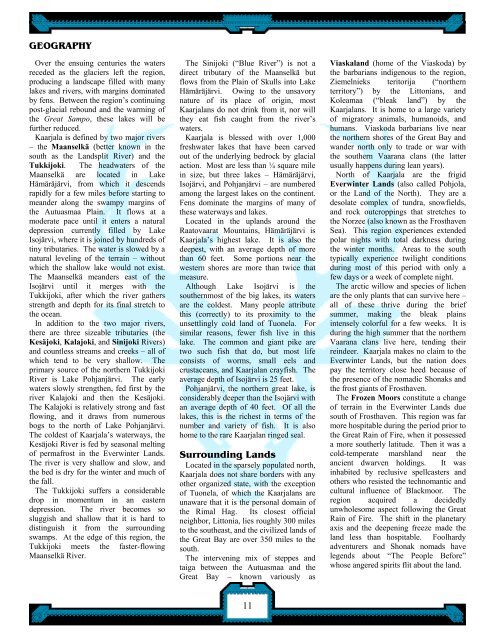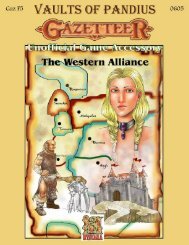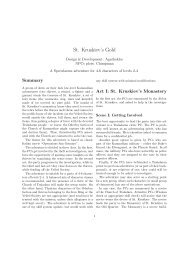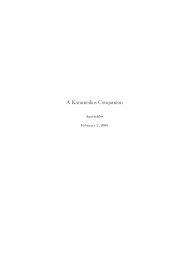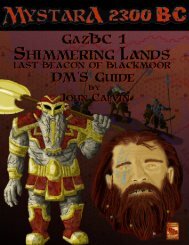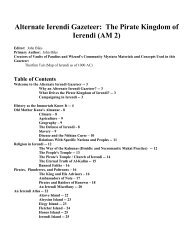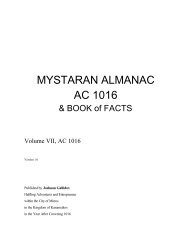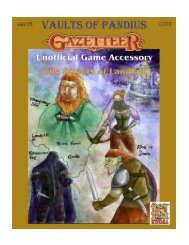Gaz F10 The Kingdom of Kaarjala - Vaults of Pandius
Gaz F10 The Kingdom of Kaarjala - Vaults of Pandius
Gaz F10 The Kingdom of Kaarjala - Vaults of Pandius
You also want an ePaper? Increase the reach of your titles
YUMPU automatically turns print PDFs into web optimized ePapers that Google loves.
GEOGRAPHYOver the ensuing centuries the watersreceded as the glaciers left the region,producing a landscape filled with manylakes and rivers, with margins dominatedby fens. Between the region’s continuingpost-glacial rebound and the warming <strong>of</strong>the Great Sampo, these lakes will befurther reduced.<strong>Kaarjala</strong> is defined by two major rivers– the Maanselkä (better known in thesouth as the Landsplit River) and theTukkijoki. <strong>The</strong> headwaters <strong>of</strong> theMaanselkä are located in LakeHämäräjärvi, from which it descendsrapidly for a few miles before starting tomeander along the swampy margins <strong>of</strong>the Autuasmaa Plain. It flows at amoderate pace until it enters a naturaldepression currently filled by LakeIsojärvi, where it is joined by hundreds <strong>of</strong>tiny tributaries. <strong>The</strong> water is slowed by anatural leveling <strong>of</strong> the terrain – withoutwhich the shallow lake would not exist.<strong>The</strong> Maanselkä meanders east <strong>of</strong> theIsojärvi until it merges with theTukkijoki, after which the river gathersstrength and depth for its final stretch tothe ocean.In addition to the two major rivers,there are three sizeable tributaries (theKesäjoki, Kalajoki, and Sinijoki Rivers)and countless streams and creeks – all <strong>of</strong>which tend to be very shallow. <strong>The</strong>primary source <strong>of</strong> the northern TukkijokiRiver is Lake Pohjanjärvi. <strong>The</strong> earlywaters slowly strengthen, fed first by theriver Kalajoki and then the Kesäjoki.<strong>The</strong> Kalajoki is relatively strong and fastflowing, and it draws from numerousbogs to the north <strong>of</strong> Lake Pohjanjärvi.<strong>The</strong> coldest <strong>of</strong> <strong>Kaarjala</strong>’s waterways, theKesäjoki River is fed by seasonal melting<strong>of</strong> permafrost in the Everwinter Lands.<strong>The</strong> river is very shallow and slow, andthe bed is dry for the winter and much <strong>of</strong>the fall.<strong>The</strong> Tukkijoki suffers a considerabledrop in momentum in an easterndepression. <strong>The</strong> river becomes sosluggish and shallow that it is hard todistinguish it from the surroundingswamps. At the edge <strong>of</strong> this region, theTukkijoki meets the faster-flowingMaanselkä River.<strong>The</strong> Sinijoki (“Blue River”) is not adirect tributary <strong>of</strong> the Maanselkä butflows from the Plain <strong>of</strong> Skulls into LakeHämäräjärvi. Owing to the unsavorynature <strong>of</strong> its place <strong>of</strong> origin, most<strong>Kaarjala</strong>ns do not drink from it, nor willthey eat fish caught from the river’swaters.<strong>Kaarjala</strong> is blessed with over 1,000freshwater lakes that have been carvedout <strong>of</strong> the underlying bedrock by glacialaction. Most are less than ¼ square milein size, but three lakes – Hämäräjärvi,Isojärvi, and Pohjanjärvi – are numberedamong the largest lakes on the continent.Fens dominate the margins <strong>of</strong> many <strong>of</strong>these waterways and lakes.Located in the uplands around theRaatovaarat Mountains, Hämäräjärvi is<strong>Kaarjala</strong>’s highest lake. It is also thedeepest, with an average depth <strong>of</strong> morethan 60 feet. Some portions near thewestern shores are more than twice thatmeasure.Although Lake Isojärvi is thesouthernmost <strong>of</strong> the big lakes, its watersare the coldest. Many people attributethis (correctly) to its proximity to theunsettlingly cold land <strong>of</strong> Tuonela. Forsimilar reasons, fewer fish live in thislake. <strong>The</strong> common and giant pike aretwo such fish that do, but most lifeconsists <strong>of</strong> worms, small eels andcrustaceans, and <strong>Kaarjala</strong>n crayfish. <strong>The</strong>average depth <strong>of</strong> Isojärvi is 25 feet.Pohjanjärvi, the northern great lake, isconsiderably deeper than the Isojärvi withan average depth <strong>of</strong> 40 feet. Of all thelakes, this is the richest in terms <strong>of</strong> thenumber and variety <strong>of</strong> fish. It is alsohome to the rare <strong>Kaarjala</strong>n ringed seal.Surrounding LandsLocated in the sparsely populated north,<strong>Kaarjala</strong> does not share borders with anyother organized state, with the exception<strong>of</strong> Tuonela, <strong>of</strong> which the <strong>Kaarjala</strong>ns areunaware that it is the personal domain <strong>of</strong>the Rimal Hag. Its closest <strong>of</strong>ficialneighbor, Littonia, lies roughly 300 milesto the southeast, and the civilized lands <strong>of</strong>the Great Bay are over 350 miles to thesouth.<strong>The</strong> intervening mix <strong>of</strong> steppes andtaiga between the Autuasmaa and theGreat Bay – known variously asViaskaland (home <strong>of</strong> the Viaskoda) bythe barbarians indigenous to the region,Ziemelnieks teritorija (“northernterritory”) by the Littonians, andKoleamaa (“bleak land”) by the<strong>Kaarjala</strong>ns. It is home to a large variety<strong>of</strong> migratory animals, humanoids, andhumans. Viaskoda barbarians live nearthe northern shores <strong>of</strong> the Great Bay andwander north only to trade or war withthe southern Vaarana clans (the latterusually happens during lean years).North <strong>of</strong> <strong>Kaarjala</strong> are the frigidEverwinter Lands (also called Pohjola,or the Land <strong>of</strong> the North). <strong>The</strong>y are adesolate complex <strong>of</strong> tundra, snowfields,and rock outcroppings that stretches tothe Norzee (also known as the FrosthavenSea). This region experiences extendedpolar nights with total darkness duringthe winter months. Areas to the southtypically experience twilight conditionsduring most <strong>of</strong> this period with only afew days or a week <strong>of</strong> complete night.<strong>The</strong> arctic willow and species <strong>of</strong> lichenare the only plants that can survive here –all <strong>of</strong> these thrive during the briefsummer, making the bleak plainsintensely colorful for a few weeks. It isduring the high summer that the northernVaarana clans live here, tending theirreindeer. <strong>Kaarjala</strong> makes no claim to theEverwinter Lands, but the nation doespay the territory close heed because <strong>of</strong>the presence <strong>of</strong> the nomadic Shonaks andthe frost giants <strong>of</strong> Frosthaven.<strong>The</strong> Frozen Moors constitute a change<strong>of</strong> terrain in the Everwinter Lands duesouth <strong>of</strong> Frosthaven. This region was farmore hospitable during the period prior tothe Great Rain <strong>of</strong> Fire, when it possesseda more southerly latitude. <strong>The</strong>n it was acold-temperate marshland near theancient dwarven holdings. It wasinhabited by reclusive spellcasters andothers who resisted the technomantic andcultural influence <strong>of</strong> Blackmoor. <strong>The</strong>region acquired a decidedlyunwholesome aspect following the GreatRain <strong>of</strong> Fire. <strong>The</strong> shift in the planetaryaxis and the deepening freeze made theland less than hospitable. Foolhardyadventurers and Shonak nomads havelegends about “<strong>The</strong> People Before”whose angered spirits flit about the land.11


